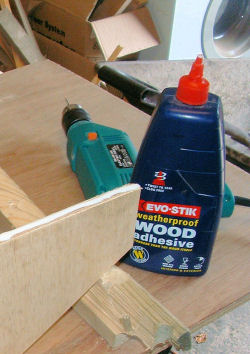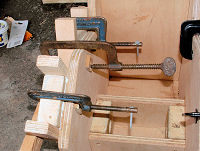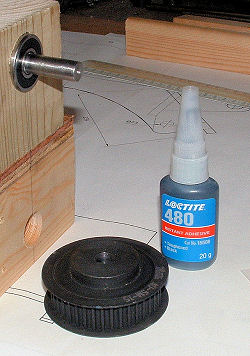The two main types of adhesive used in the vehicle
builds shown on the site are conventional PVA type wood
glues and the slightly less well known but still readily
available industrial type super glues or cyanoacrylates.
 Wood
adhesive probably doesn't need much of an
introduction. I use a relatively quick setting
weatherproof formulation of the type available in most
hardware/DIY stores and find I generally obtain high
strength trouble free joints in the timber chassis
structures. The
usual tips apply - make sure the surfaces to be bonded
are dry and clean, if possible load the joint while the
adhesive sets and, whilst the glue is wet, clean off the
excess squeezed out of the joint with a finger or cloth.
- simple (health & safety note - don't
eat wood adhesive!).
Wood
adhesive probably doesn't need much of an
introduction. I use a relatively quick setting
weatherproof formulation of the type available in most
hardware/DIY stores and find I generally obtain high
strength trouble free joints in the timber chassis
structures. The
usual tips apply - make sure the surfaces to be bonded
are dry and clean, if possible load the joint while the
adhesive sets and, whilst the glue is wet, clean off the
excess squeezed out of the joint with a finger or cloth.
- simple (health & safety note - don't
eat wood adhesive!).
One point that is worth making is the
importance of straight cut flat edges on the parts to be
joined. To achieve strong joints the contacting faces of
the joint must be brought into intimate contact with
each other. Unevenly cut edges on the parts to be joined
will produce high points and, in consequence, will also
produce gaps in the contact areas between these high points - this loss of
bond area does not make for strong adhesive joints.
Machine cut edges or edges planed or sanded
dead-straight after cutting are best - it's worth taking
the time to get this right before reaching for the
adhesive bottle.

 A second important point to consider is that although
wood
glue
is tremendously strong when set, the adhesive joint's
strength is off course also limited by the strength of the parent
materials. This is particularly important when a
structure requires bonds made to the face of plywood
sheet - the strength of the adhesive used in the
manufacture of the sheet to bond the individual plies
may not match that of your wood glue and such joints
placed in tension may fail through delamination of the
sheet. In these circumstances consider reinforcement of
the bonded joint with screws or other mechanical
fasteners.
A second important point to consider is that although
wood
glue
is tremendously strong when set, the adhesive joint's
strength is off course also limited by the strength of the parent
materials. This is particularly important when a
structure requires bonds made to the face of plywood
sheet - the strength of the adhesive used in the
manufacture of the sheet to bond the individual plies
may not match that of your wood glue and such joints
placed in tension may fail through delamination of the
sheet. In these circumstances consider reinforcement of
the bonded joint with screws or other mechanical
fasteners.
Instant Adhesives - I've used cyanoacrylate
instant adhesives for some time now for fixing steel
chain sprockets, belt pulleys and gears onto steel drive
shafts. This is as an alternative to conventional power
transmission
component fixing methods such as keys or splines which
I've tried to avoid in my pursuit of simple
manufacturing technology designs. Using instant
adhesives to do this job has proved remarkably effective
in the modestly powered EV's I've built, although there
will be a shaft torque level at which bonding alone will
not be sufficient.
 Simple
straight bored holes in the sprocket/gears and unstepped
parallel shafts can be used - no steps or grooves need
be machined in the shaft, although the joint diametral
clearance does have to be controlled. Standard sized
bright steel shafting can be used with the sprocket/gear
bore drilled to give the required fit. To bond steel to
steel I use Loctite 480, this is a rubber toughened
cyanoacrylate with enhanced shock resistance and, very
usefully, a slower cure speed than most instant
adhesives. On steel/steel joints it sets in 60 to
120 seconds which gives time to work the adhesive fully
into the shaft/hole gap to produce as closely as
possible a full area bond. Full strength is developed
after curing for about 24 hours at room temperature.
Shear strengths for Loctite 480 on steel are quoted at
22 to 30 N/mm2 which is approximately 20% of the shear
strength of mild steel. As an indication of torque
capacity a 100% bond area between a steel Ø16 mm
diameter shaft and a 25mm long bossed sprocket will have
a theoretical torque capacity of 221 to 302 Nm.
Appropriate generous design margins are needed in
practice however -
even with these margins working torques of 30 to 40 Nm
should be quite achievable on our Ø16 shaft. As a quick
comparison it is worth noting
Simple
straight bored holes in the sprocket/gears and unstepped
parallel shafts can be used - no steps or grooves need
be machined in the shaft, although the joint diametral
clearance does have to be controlled. Standard sized
bright steel shafting can be used with the sprocket/gear
bore drilled to give the required fit. To bond steel to
steel I use Loctite 480, this is a rubber toughened
cyanoacrylate with enhanced shock resistance and, very
usefully, a slower cure speed than most instant
adhesives. On steel/steel joints it sets in 60 to
120 seconds which gives time to work the adhesive fully
into the shaft/hole gap to produce as closely as
possible a full area bond. Full strength is developed
after curing for about 24 hours at room temperature.
Shear strengths for Loctite 480 on steel are quoted at
22 to 30 N/mm2 which is approximately 20% of the shear
strength of mild steel. As an indication of torque
capacity a 100% bond area between a steel Ø16 mm
diameter shaft and a 25mm long bossed sprocket will have
a theoretical torque capacity of 221 to 302 Nm.
Appropriate generous design margins are needed in
practice however -
even with these margins working torques of 30 to 40 Nm
should be quite achievable on our Ø16 shaft. As a quick
comparison it is worth noting
 that
the rated torque output of a 1000W, 3500rpm electric
motor is a touch over 3 Nm.
that
the rated torque output of a 1000W, 3500rpm electric
motor is a touch over 3 Nm.
For the pin/hole fit I've found diametral clearances of
0.1 mm to 0.15 mm work well although I've used larger gap
sizes and still made functional joints. To remove a
bonded component from a shaft it is usually necessary to
heat the joint to 150° C or above to weaken the
adhesive. The part can then be knocked off the shaft (or vica versa). If possible use fresh adhesive - my
experience of using out-of-date- adhesive is that the
set time gets longer and longer although apparently
strong (ie haven't failed yet) joints still appear to be
produced.
Thread Locking - A further application of
cyanoacrylates is for thread locking. Loctite and
several other instant adhesive manufacturers produce
thread locking formulations (see image right) for retaining nuts on
bolts/screws etc and are very useful where secure
connections are important such as on steering, braking
and wheel securing situations. You may also be
interested in anerobic adhesives in these situations -
ie mainly liquid adhesives which set in the absence of
oxygen.
